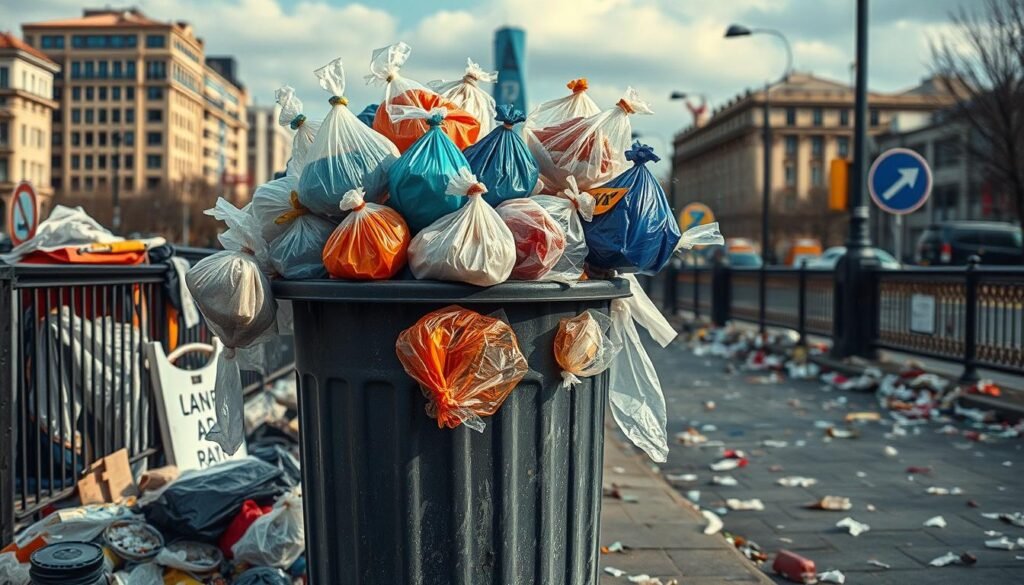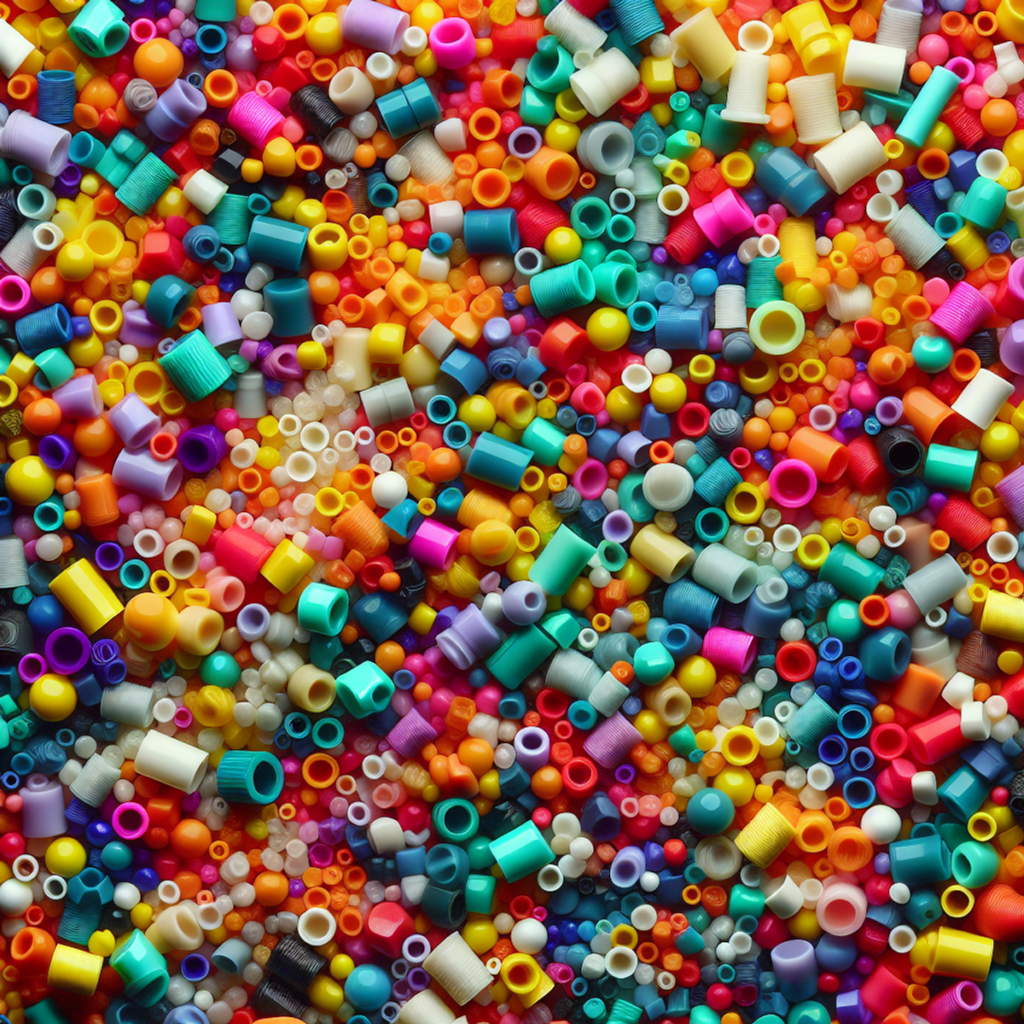Is it possible for a product that lasts over 500 years to help build a green future? Every year, the U.S. uses an astounding 100 billion plastic bags. This fact makes some people doubt they can be recycled. But truthfully, plastic bags are 100% recyclable. Moving past common myths, we discover the real facts about recycling plastic bags. We also look at new steps toward being environmentally friendly. These steps help make a world that’s better at recycling and stronger for it.
Key Takeaways
- Research indicates plastic bags, including those made from LDPE and HDPE, can be fully integrated into recyclable materials systems.
- Advances like A-Pac Manufacturing’s integration of plant-based materials in poly bags potentially cut carbon footprints by up to 20%.
- Technological improvements such as NuPlastiQ® significantly enhance the biodegradation process of plant-based polymers.
- The adoption of poly bags crafted from recycled contents fosters the principles of a circular economy.
- Domestic recycling efforts, greatly through retailers like Kroger, Safeway, Target, and Walmart, play a critical role in diverting plastic bags from landfills.
- Understanding the true lifespan of plastic bags and the current technological capabilities could revolutionize our approach to sustainable living.
Understanding Plastic Bag Usage and Environmental Impact
Every year, around 100 billion single-use plastic bags are used in the US. This results in a lot of plastic waste and landfill contamination. It’s a big problem for our environment and sustainability.
The Prevalence of Plastic Bags in Daily Life is clear. On average, 365 plastic bags are used per person each year in America. Even though people know it harms the environment, the convenience keeps them in use.
Legislation Against Single-Use Plastic Bags Across States is making progress. California was the first to ban them in 2014. When Ireland added a plastic bag tax, use dropped by 90%. Now, over 127 countries have laws against single-use plastic bags. You can learn more about this at forms of single-use plastic bag legislation.
Environmental Risks: Landfills and Oceans are suffering because of plastics. Only 1 in 200 plastic bags get recycled. In fact, 87% of these plastics end up in the ocean or landfills. This harms marine life, like sea turtles, many of which have eaten plastic.
To fix the plastic waste problem, we need to support environmental legislation and recycle more. Using better plastic recycling methods will help reduce landfill contamination. Successful examples from some states and countries show how laws and recycling can make a big difference.
The Historical Context of Plastic Bags and Recycling Efforts
The history of plastic bags is rich and complex. It begins with their invention and spans to today’s eco-challenges. They were first made to be reusable and fight deforestation. Now, they are a convenience and an environmental worry.
The Invention of the Plastic Bag
The plastic shopping bag we use was made in 1965 by Sweden’s Celloplast. Their goal was a light, waterproof, strong alternative to cloth and paper bags. The plastic bag invention aimed to be reusable, cutting down on paper and saving trees.
Are Plastic Bags Recyclable? Dispelling Myths and Realities
Recycling myths aside, plastic bags are 100% recyclable. They’re mostly made from HDPE or LDPE, which recycling centers can process. Yet, a big difference exists between their recyclability and how much is actually recycled. The EPA notes less than 10% of plastic bags in the U.S. get recycled. This issue is often due to misinformation and lack of recycling programs.
Let’s look at recycling plastic bags through history and today:
| Year | Event | Impact |
|---|---|---|
| 1972 | First U.S. Plastic Waste Recycling Mill | Established in Conshohocken, Pennsylvania, setting a precedent for future facilities. |
| 1984 | Significant Recycling Milestone | Approximately 100 million pounds of plastic collected nationwide. |
| 1988 | Introduction of Recycling Symbol | The triangular symbol becomes a universal identifier for plastic recycling. |
| 2007 | Recycling Achievements | Over a third of recycled plastic film in the U.S. used to create composite lumber. |
Recycling plastic bags helps conserve natural resources and cuts our environmental impact. Recycling a ton saves the energy equivalent of nine barrels of oil. This underscores the importance of recycling efforts.
In conclusion, the history of plastic bags blends innovation with global usage. The path to responsible use and better recycling is still being paved. Overcoming recycling myths and sharing the true recyclability of plastic bags are key steps.
The Lifecycle of a Plastic Bag: Usage and Disposal
The plastic bag lifecycle begins at manufacturing plants and often ends in landfills or oceans. Every year, the US alone uses around 100 billion plastic bags. This shows the huge problem of disposal challenges. A single plastic bag, typically used for just 12 minutes, can take up to 1,000 years to degrade.
Average Duration of Plastic Bag Use
The time a plastic bag is used is surprisingly short. They are quickly thrown away after one use, turning into non-biodegradable waste. This contrast points out the big issues with recycling difficulties. It also shows why we need to act fast on plastic waste.
Challenges of Recycling vs. Single-Use Tendency
Plastic bags are tough to recycle, which is made worse by recycling costs. Recycling a bag costs more in energy and money than making a new one. This makes us use them once and throw them away. In the US, only about 1% of plastic bags get recycled. This is very little compared to how many we make. We need to use reusable bags more and better recycling tech to solve this.

Understanding and rethinking the disposal challenges of plastic bags is key. We must look at their lifecycle, our habits, and how we recycle.
We need everyone – shoppers and leaders – to work for better recycling and to know the dangers of plastic pollution. This is how we fight the problem effectively.
“Forever Pollution”: The Longevity of Plastic in our Environment
‘Forever pollution’ shows how plastics, unable to degrade, constantly harm our environment. Their chemical makeup prevents them from breaking down. This causes ongoing pollution and adds microplastics to our ecosystems.
Most plastic waste comes from packaging and throwaway items. It piles up around us and harms both land and sea habitats. Microplastics in these places are especially worrying. They can get into food chains, affecting our health.
It’s key to grasp the lasting damage this waste causes. Let’s review some data that shed light on the issue and the attempts to fix it:
| Statistic | Impact or Initiative |
|---|---|
| Amount of packaging waste in Europe (2021) | 189 kg per capita, an increase of nearly 32 kg in a decade |
| EU recycling targets for 2030 | Aims to recycle 100% of packaging and plastic |
| France’s anti-waste law (2023) | Prohibits all disposable tableware in fast-food outlets |
| Global marine animal deaths per year by plastic waste | Estimated over 100 million |
| Percentage of recycled plastic historically | Only 9%, with 60% ending up in landfills or oceans |
This information shows the huge problem of non-biodegradable waste. But it also shows the efforts to tackle pollution. Working on solving plastic pollution is crucial for our planet.
Many are working hard to lessen the impacts of this pollution. To really make a difference, everyone must work together. We need fresh ideas, strong rules, and teamwork.
Are Plastic Bags Recyclable? Where Technology Stands Today
New tech offers solutions to the recycling issues of plastic bags. These bags are mostly made from materials like HDPE, LDPE, and LLDPE. They are at the heart of recycling talks due to their common use and effect on the environment.
Despite being recyclable, only 5% of US-made plastic gets recycled. This is often because there aren’t enough facilities or people don’t know about the process. Yet, places like California are making big changes. By 2032, they want nearly all single-use items to be recyclable or compostable.
Tech progress in recycling HDPE, LDPE, and LLDPE is key. For example, Trex turned 12.6 million pounds of plastic films into green products in 2020. Also, the Center for EcoTechnology has helped keep over 26,000 tons of waste out of landfills.
These tech improvements are supported by regulatory changes. The Federal Trade Commission (FTC) is asked to make the rules for recyclable product labels stricter. They want to increase the threshold from 60% to 90%. This could lead to more plastics being recycled instead of harming nature.
In conclusion, recycling LDPE, HDPE, and LLDPE looks promising thanks to tech and policy changes. The hurdles are big, but ongoing progress and new rules show a hopeful path. This path leads to better care for our environment through improved recycling of plastics.
Recycling Infrastructure: From Curbside Collection to Recycling Facilities
The growth in recycling infrastructure development is key to meeting growing waste challenges. Strong recycling programs at the local and state levels have made curbside collection better. They’ve also led to new, smart solutions in recycling tech.
Local and State Recycling Programs
Americans now throw away about 4.51 pounds of trash each day, a big jump from 2.68 pounds in 1960. This makes the need for good recycling programs more important than ever. Better recycling infrastructure development helps sort waste better and reduce mixing, which was a big problem with single-stream systems.
In these systems, about a quarter of the materials got mixed up. Local efforts are now looking at special categories for recycling hard-to-handle items like plastic film. In 2018, only 11% of plastic film was recycled, even though the U.S. created nearly 9 billion pounds of it. States are setting tougher rules to help reduce how much trash goes to landfills.
Innovations in Plastic Bag Recycling Technology
As recycling faces more challenges, we’re seeing more tech developments for turning plastic waste into useful products. This is also because we need to figure out how to recycle plastics that were tough to handle before. Companies like EFS-Plastics are now turning 70% to 80% of plastic film bales into new products, showing real progress in recycling technology.
Being able to tell different plastics apart is crucial for this progress, as seen in how we identify and sort plastics. For example, PET bottles are only collected for recycling 29% of the time. The American Chemistry Council has set a bold goal: by 2030, all plastics should either be recyclable or able to be recovered. This goal stresses the need to push recycling tech forward.

To understand both the advancements and challenges, the table below shows how recycling rates and contamination levels have changed over the years:
| Material | Recycling Rate (2017) | Contamination Issues |
|---|---|---|
| PET Bottles | 29% | High |
| Plastic Film | 11% | Moderate |
| Textiles | 15.2% | Low |
This information highlights the ongoing need for investment. We must keep supporting recycling at the local and state levels. And we should encourage worldwide recycling innovation for a greener future.
Corporate Responsibility: Retailers and Recycling Initiatives
Large retailers are becoming key in moving towards sustainable business practices. This is especially true with their corporate recycling initiatives. Stores like Kroger, Safeway, Target, and Walmart now have retail recycling bins for plastic bags. They recognize their big role in spreading and potentially recycling these items.
By doing this, retailers not only help recycle plastics but also educate the community. They show the importance of handling waste properly and the hard parts of recycling plastic bags. With their big reach and daily talks with customers, these stores can change how people act. They can encourage caring for the environment from the ground up.
The challenge with recycling plastic bags is complex. Even though these bags are collected in retail recycling bins, they face many hurdles in the recycling process. Problems with recycling machines, sorting issues because they are light and bendy, and low demand in recyclable markets are just some of the issues. Hence, while it’s great that these bags are being collected, there’s a lot more to do to make recycling them fully effective.
| Initiative | Description | Impact |
|---|---|---|
| Store Recycling Bins | Big retailers provide in-store bins for collecting used plastic bags. | Encourages recycling directly at the point of consumption. |
| Employee Training | Front-service clerks are taught proper bagging techniques, promoting the use of fewer or no plastic bags. | Reduces the initial distribution of plastic bags. |
| Reuse and Upcycling Programs | Encouragement of using reusable bags and creative upcycling of plastic bags into new products. | Lessens the environmental impact by diverting waste from landfills. |
Integrating corporate recycling initiatives into daily business work not only matches sustainable business practices but also raises the bar. By putting their efforts together and focusing on the community, retailers can turn the problem of plastic waste into a chance to lead in guarding the environment.
The Not So Green Reality of Biodegradable Bags
As people become more aware of the environment, they are choosing biodegradable plastic bags more often. These bags are said to be better than regular plastic bags. But looking closer, we see the issue is more complicated with many challenges.
The Debate Over Biodegradability Claims
A lot of people think biodegradable bags break down everywhere. But they don’t. A long study found that, over three years, these bags didn’t decompose well in different places. It makes us question the environmental claims by those who make these bags. Also, in the U.K., only three percent of these bags end up where they can compost right. Most are just thrown away or burned.
It’s surprising but regular plastic bags can break into smaller pieces in 18 months if left outside. Yet, these bits of plastic can hurt the environment, getting into soil and water. Compostable bags only break down in special places designed for them. Most trash systems don’t have these special conditions.
Environmentally Friendly Alternatives
If we really want to help the planet, we need to choose better alternatives. Companies like Footprint are choosing materials made from plants instead of bioplastics. They believe this is a more sincere way to be eco-friendly. It’s not just about switching one type of bag for another.
The table below shows how different bags decompose and why some are better for the planet:
| Type of Bag | Decomposition Environment | Decomposition Time |
|---|---|---|
| Standard Plastic Bags | Air Exposure | Up to 18 months |
| Compostable Bags | Industrial Composting | 10 to 60 days |
| Biodegradable Bags | Varied Conditions | Does not fully decompose |
| Plant-Based Bags (Footprint) | Soil (Industrial Composting) | Effective degradation |
In the end, biodegradable plastic bags have some good points but they aren’t the complete answer. People need to think hard about using biodegradable and compostable bags. We should lean towards materials from plants. They offer a better way to take care of our planet.
Action and Accountability: The Role of Businesses and Consumers
The fight against plastic waste pollution has spotlighted the combined role of businesses and consumers. Evidence shows that replacing a disposable plastic water bottle with a reusable one in the US could avoid billions of bottles ending up as waste each year. As companies like 4ocean lead with recycled materials and ocean cleanup efforts, sustainable practices are essential. This creates a space where consumers and corporations work together to cut down plastic waste.
Adopting Sustainable Practices in Commerce
Corporate America is changing, with big names and start-ups choosing recycled materials. This reduces the need for new plastic. States like California and Maine have Extended Producer Responsibility laws. These laws push producers to pay for recycling their packaging. This shift towards holding producers responsible supports a sustainable, circular economy. The Circular Economy Development Center in Colorado is a prime example of moving towards a more sustainable economy, showing the way for reduced waste and better local economies.
Community Action Towards Reducing Plastic Bag Consumption
Community initiatives play a huge part in building an eco-friendly society. The switch to reusable shopping bags has greatly cut down on plastic bag litter. Places like Northern Virginia have adopted measures like plastic bag taxes to push this change. After a ban on single-use plastics ended, Pennsylvania saw local governments step up. They educate their citizens, offer resources, and lead conservation efforts. This shows how important it is for communities to work together on environmental care, making a real difference in fighting plastic waste.
FAQ
Are plastic bags actually recyclable?
Yes, plastic bags are 100% recyclable. They are often made from materials like HDPE, LDPE, or LLDPE. These can be processed with specialized recycling machines.
What is being done to reduce the use of single-use plastic bags?
Laws against single-use plastic bags exist in many U.S. states to cut down their environmental harm. Also, an increase in recycling programs and awareness campaigns helps lessen plastic bag use.
How long does it take for a plastic bag to decompose, and what are the environmental risks?
A plastic bag can take up to 500 years to break down. During this time, they can release microplastics into the environment. This poses grave risks to marine life and our surroundings.
Who invented the plastic bag and was it meant to be disposable?
Engineer Sten Gustaf Thulin invented the plastic bag in the 1960s. He meant for the bags to be reused, aiming to save trees and offer an alternative to paper bags.
How long is each plastic bag used on average before being thrown away?
People generally use plastic bags for just about 12 minutes before tossing them out.
What is “forever pollution” and how do plastic bags contribute to it?
“Forever pollution” talks about the lasting damage caused by items that don’t break down, like plastic bags. Their slow degradation means they pollute the environment for a very long time.
How have recent technological advancements impacted plastic bag recycling?
New technology has led to better machines that can recycle plastic bags more efficiently. This improves the process for recycling plastic bag solutions.
How do current recycling infrastructures handle plastic bags?
Plastic bags need a specific type of recycling setup because of their material. More places are now able to process these bags as technology gets better and laws demand proper waste handling.
Why are biodegradable bags not always the greenest solution?
Biodegradable bags seem better for the earth, but there’s a catch. Some may break down slowly and, in big numbers, might not help much with the plastic problem.
How can businesses and consumers play a role in reducing plastic bag waste?
Companies can come up with new recycling programs and go green in their operations. Consumers can join in local efforts to use fewer plastic bags. Working together, we can push for a more sustainable and responsible approach to handling plastic waste.






